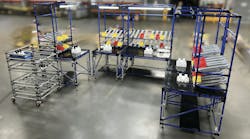Businesses in the industrial sector have a handful of options for completing voltage rectification or conversion at the work site. At the most basic level, transformers are commonly utilized for such purposes.
By definition, a transformer is a device used for decreasing (step down) or increasing (step up) voltages (primary to secondary). Furthermore, some units are configured for conversion from AC to DC, providing operators access to low voltage current (useful for outdoor locations, low-voltage lighting systems and combustible facilities).
Transformers can function on its own or as part of a larger system, such as a power distribution station. Depending on the electrical requirements of the work site, businesses must select the right type of transformer or power distribution unit, in order to maximize its applications.
This article compares and takes a closer look at buck/boost transformers, temporary power distribution units and conventional transformers.
Buck/Boost Transformer
A buck-boost transformer is a type of transformer used for minor rectification of line-in voltage (keyword here is ‘minor’). The lightweight and compact units are very economical and provide space-saving benefits. It is important to consider that buck-boost transformers cannot create a neutral and does not provide circuit isolation. Moreover, this type of transformer is designed to handle single phase or three phase voltage (via two or three units) distribution.
The term ‘buck’ refers to stepping down voltages, while ‘boost’ refers to stepping up voltages. Voltage correction with buck-boost transformers are small, such as 240V to 208V, 220V to 240V, 450V to 480V, 120V to 110V and etc. The devices can also be applied to handle low voltage distribution (12V, 24V, 32V or 48V).
In application, the units are helpful in reducing risks related to equipment failure, wear and tear of machines, excessive heat generation, line drops and voltage spikes. Buck-boost transformers can be found in industrial control rooms, data centers, uninterruptable power supplies, telecommunications, tanning beds, lighting systems and more.
Portable Power Distribution Station
Portable power distribution units are designed for temporary projects and work sites (keyword is ‘portable’). Businesses or projects that frequently use this type of transformer: MRO, construction, mining, remote facilities, military camp sites, emergency medical services, shipyards, aerospace, plant maintenance, manufacturing, labs, data centers and more.
Range of voltage rectification includes the following: 480V 3PH to 120/240V 3PH, 480V to 240D/208-120V, 120V to 12/24V AC, 240V 1PH to 120V 1PH and more. Capacities range from 10 KVA all the way to 150 KVA.
A portable power distribution station may consist of a transformer for voltage rectification, a disconnect for electrical safety, various panels (holds circuit breakers, receptacles and other connections), a line-in power cord, a set of receptacles and other devices or accessories, such as meters, receptacle covers, grounding lugs and more.
Due to its portable form factors, a temporary power distribution station offers flexibility at the work site through the extension of hard-to-reach power sources. Such units are typically mounted on sturdy carts or stable platforms. For maximum portability, the units can be equipped with forklift skid pockets, lifting eyelets and locking casters.
The stations can also be customized (during manufacturing) to meet the needs of specific projects. For example, instead of a cart with rubber wheels, a temporary power distribution unit could come equipped with tall legs for uneven terrain or flooded locations. Moreover, specific materials, including stainless steel, and NEMA-rated enclosures (NEMA 3R or NEMA 4X) could also be utilized for work sites exposed to corrosive elements. Explosion proof models are suitable for flammable facilities and hazardous locations.
Transformer (Isolation, Auto, Dry-type, Oil-filled, Pad Mount)
Stand-alone transformers are dedicated devices used for voltage control or rectification. This type of unit is built for handling large voltage ranges, such as 480V to 120/240V, 12470V Delta to 208Y/120 Wye and 13400V Delta to 400V Delta, which is also useful when a neutral is not present and for applications that require one. Capacities may range from 30 KVA to 500 KVA and 2,500 KVA or higher. Configurations may also vary, depending on the power requirements of the facility: single phase, three phase, Delta (3PH) and Wye (3PH).
Transformers are ideal for accurate voltage conversion and distribution with existing equipment at the work site. When an accessible supply line differs from the voltage requirements of machines, a transformer is applied to ensure compatibility.
Transformers can be categorized, based on their uses. An isolation transformer is a safety device with a 1:1 turns ratio and separate primary/secondary windings, which does not primarily function as a voltage converter. Instead, the device isolates circuits and facilitates the transfer of electrical power in an efficient manner, resulting in decreased noise, transient voltages and exposure to ‘dirty’ power.
An autotransformer is a unit with interconnected windings (single winding) that hosts the primary and secondary. The units are effective for standard and efficient voltage conversion at work sites.
Lastly, for large-scale voltage rectification and power distribution, dry-type, oil-filled or pad mount units are recommended. The medium-voltage units are utilized for distribution over long distances, such as from grid systems to an industrial building or commercial site.
Dry-type transformers are solid state and rely on natural cooling during operation. Suitable for indoor and outdoor locations, the units may come with cooling ducts or louvers to meet optimal operating temperature requirements. Liquid-type or oil-filled transformers leverage fluids for cooling and are mostly found outdoors. Pad-mount units refer to dry-type or liquid-filled, medium-voltage transformers for outdoor applications or underground power distribution systems. The enclosed stations may be used to step down and distribution power to local neighborhoods, large plants and commercial establishments, including malls.





